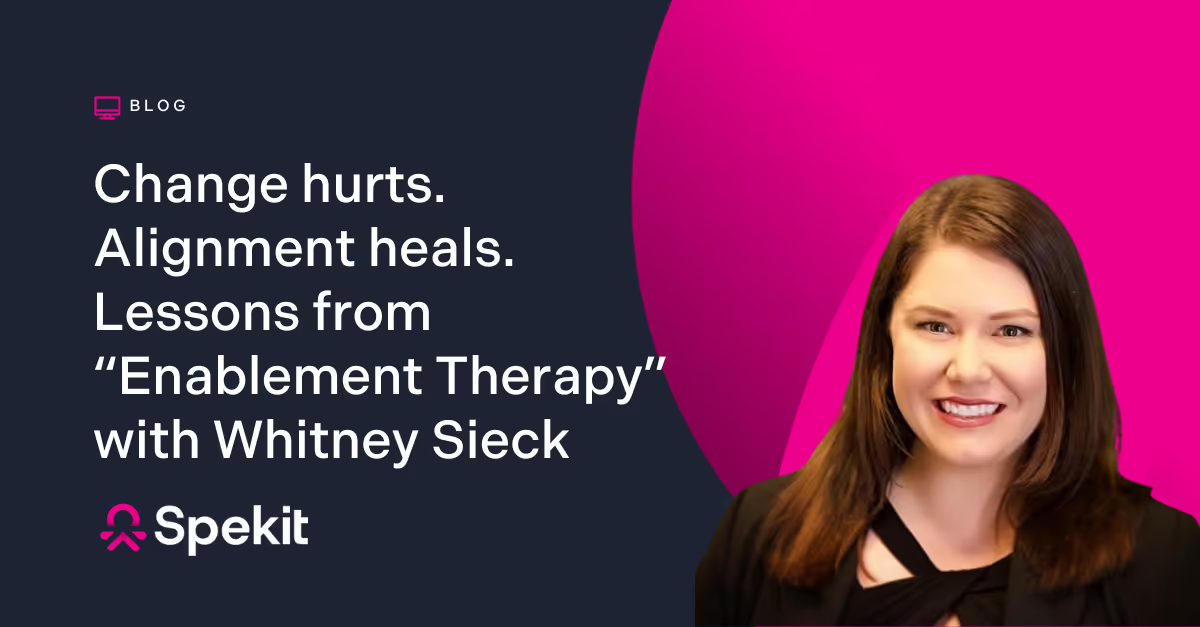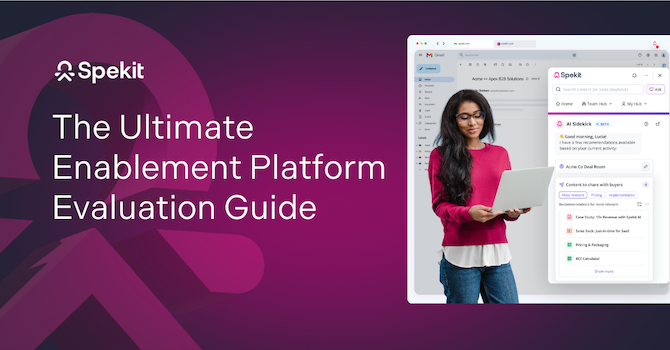Stock prices swing, budgets tighten, and your best sellers are asked to master a fresh talk track before Friday’s forecast call. Welcome to the new normal: a constant churn of product pivots, market shocks, and tool fatigue. In that swirl, enablement isn’t window dressing. It is the operating system that keeps revenue teams moving in the same direction.
That is the heart of şÚÁĎłÔąĎÍř’s recent webinar, “Change Sucks: Enablement Therapy,” where consultant, Global Head of Enablement at Intuit, and founder sat down with şÚÁĎłÔąĎÍř’s to dissect the real work behind effective change management. The conversation stretched from prioritization frameworks to neuro‑inclusive kickoff planning, weaving hard‑earned field stories with pragmatic models leaders can apply Monday morning.
What follows is a strategic recap (equal parts narrative and business case) geared for executives who refuse to let change erode productivity. Use it as a blueprint for 2025 planning.
The hidden cost of reactive enablement
When the backlog is overflowing and every request sounds urgent, enablement leaders slip into permanent launch mode. Slides go live, course links hit Slack, applause fades… and momentum stalls.
Sieck visualizes the trap as an inverted pyramid:
- Bottom layer – reactive fixes. Intake forms pile up with “quick enablement.” Nothing scales.
- Middle layer – managed process. Intake exists, but the team still chases shiny objects.
- Peak – enablement nirvana. Programs map to board‑level objectives, own reinforcement, and sustain knowledge long after go‑live.
Staying at the top requires ruthless prioritization and executive air cover. Anything else breeds false starts, dusty content, and an onboarding cliff that widens every quarter.
Executive takeaway: Ask one question of every enablement task: “Which CEO‑level objective does this advance?” If the answer is fuzzy, park it.
Launch → Reinforce → Sustain: a flywheel, not a funnel
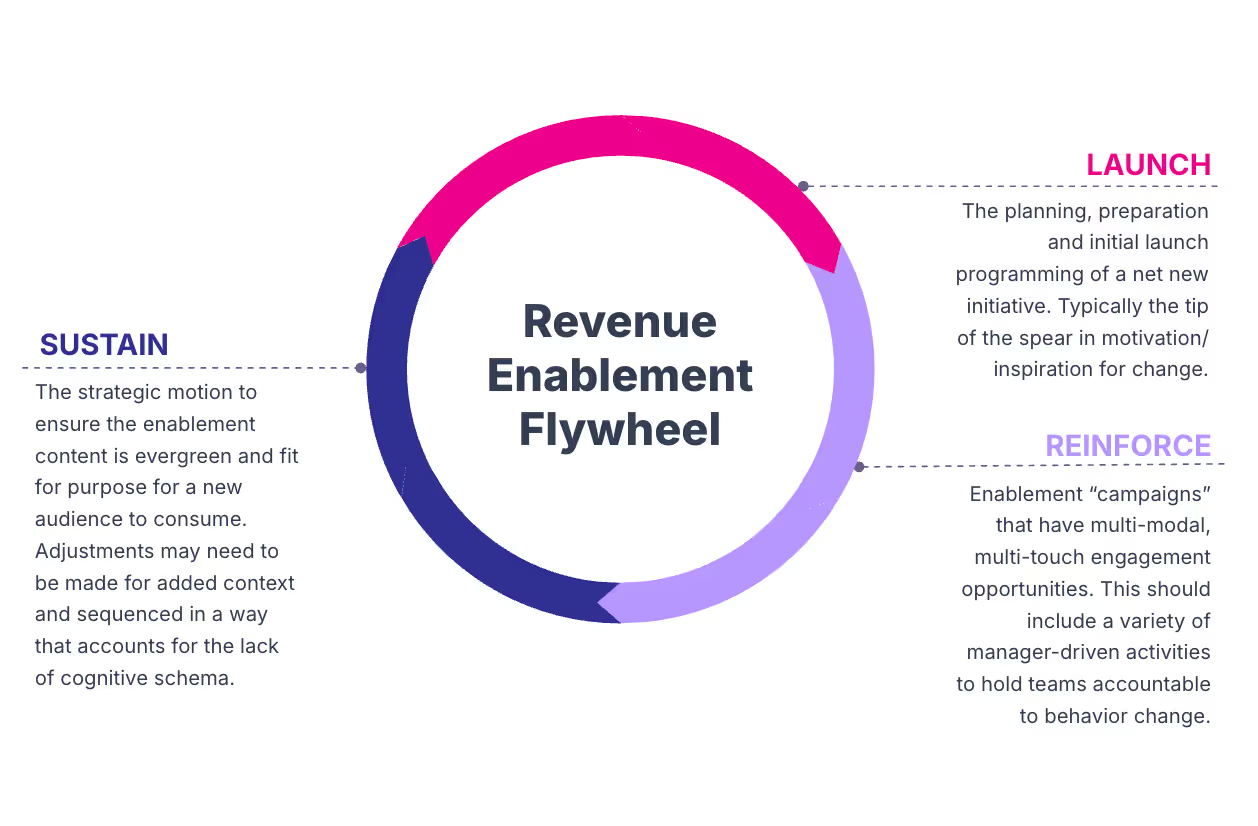
Great programs behave like recurring revenue: they compound. Whitney's flywheel reframes enablement as a continuous campaign:
- Launch. Planning, stakeholder buy‑in, net‑new content.
- Reinforce. Manager coaching, field practice, peer learning loops.
- Sustain. Update onboarding, refresh collateral, archive what expired.
Skip any stage and value leaks. Follow all three and your message survives rep turnover, territory shifts, and M&A surprises.
Uppercase vs lowercase enablement: setting boundaries that stick
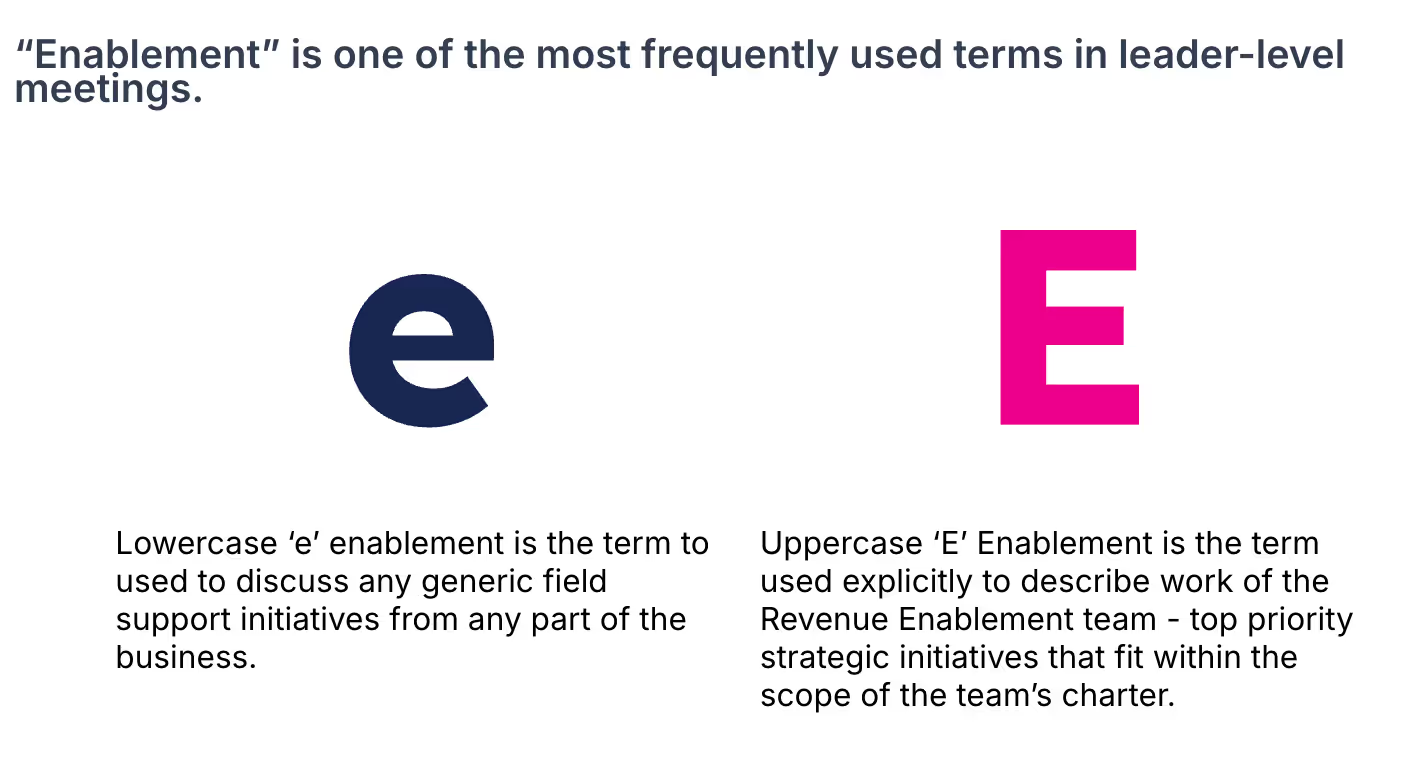
Enablement become the corporate catch‑all: need a deck? “Call enablement.” New feature? “Enablement will train.” The result is burnout and brand dilution.
Whitney's fix is deceptively simple:
- lowercase e enablement = general support, content tweaks, small‑batch training. Owned by local teams, advised by enablement.
- ±«±č±č±đ°ůł¦˛ą˛ő±đ E˛Ô˛ą˛ú±ô±đłľ±đ˛ÔłŮ = cross‑functional, board‑visible initiatives that demand flywheel investment. Fully owned by the enablement org.
Teach the vocabulary, celebrate it in meetings, and watch clarity ripple across product, marketing, and sales ops.
Leadership move: During QBRs, tag each new request “E” or “e.” Force teams to justify an uppercase label with data and executive sponsorship.
Gray‑area bingo: partnering with RevOps for clean handoffs
Misaligned metrics torpedo credibility. That is why Whitney runs a “gray‑area” exercise with Revenue Ops at every new company:
- Draw a nine‑cell grid.
- List ambiguous responsibilities—report building, tech governance, certification scoring, etc.
- Each team secretly marks ownership (Enablement or Ops) for every cell.
- Compare, debate, decide, and document a living RACI.
The process surfaces silent assumptions before they harden into turf wars. It also accelerates analytics: once both teams agree on data sources and definitions, dashboards ship faster and insight quality jumps.
Metric spotlight: Velocity (average deal size × win rate ÷ cycle length) becomes a single pane of glass for AEs, managers, and executives. Enablement can then design peer‑led sessions around reps with standout velocity profiles, converting numbers into storytelling.
Managing complex change: the five‑ingredient checklist
Borrowed from 1980s change‑management theory, Whitney's matrix remains razor‑sharp.
Use it pre‑launch to smoke‑test programs, and post‑launch as a retro lens. The model turns nebulous “vibes” into concrete fixes—add incentive spiffs, clarify roles, supply templates.
Board‑level win: Connecting each missing ingredient to productivity impact reframes enablement work as operational risk reduction, a narrative CFOs respect.
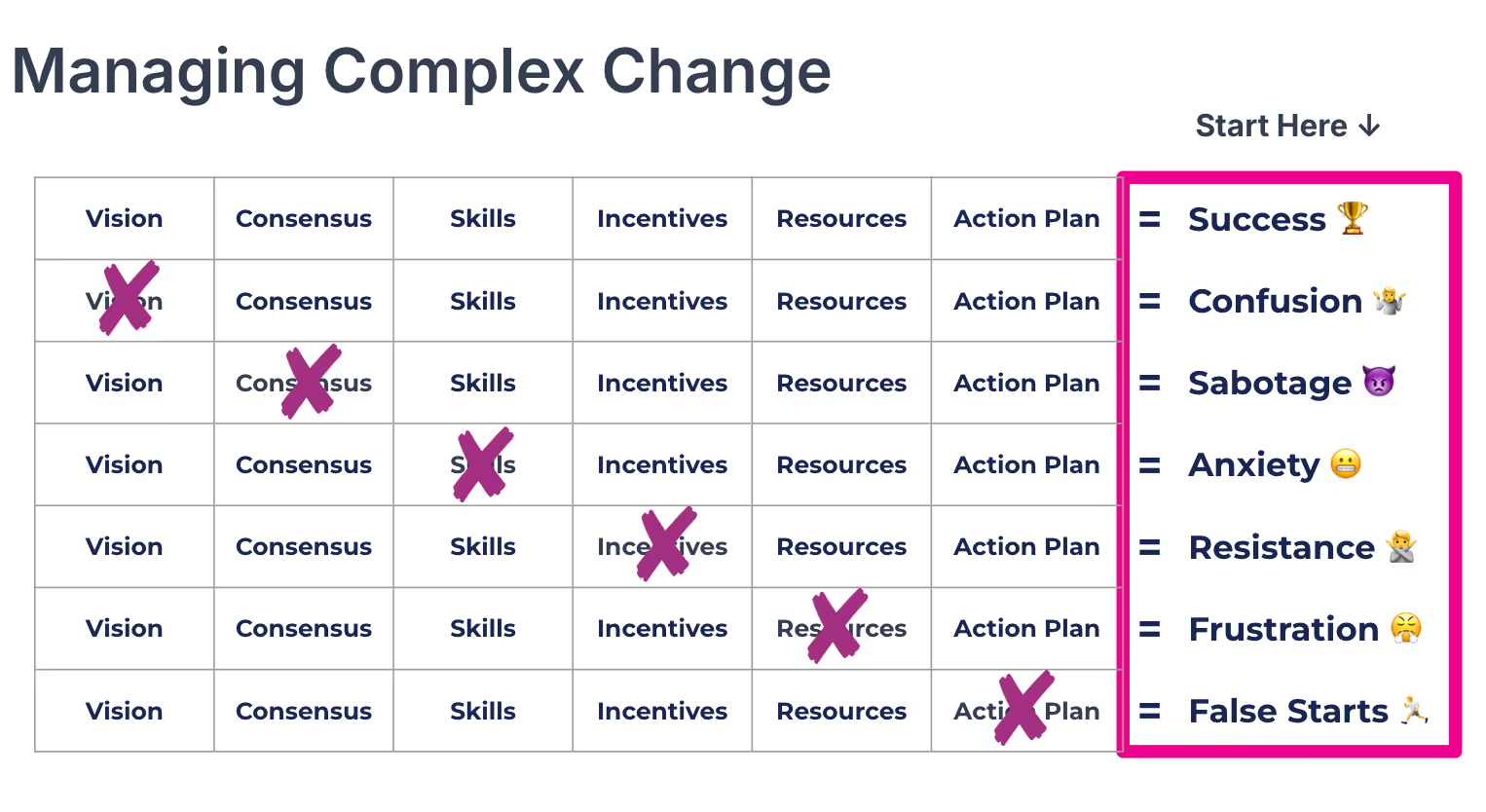
From data dumps to decision fuel: a four‑level measurement stack
Kirkpatrick remains the gold standard, but Whitney translates it into revenue English:
- Participation. Attendance, completion.
- Perception. Session scores, confidence lift.
- Proficiency. Certifications, call‑score improvements.
- Performance. Pipeline velocity, renewal rates, overall productivity.
Layer 1‑3 metrics live in enablement platforms; layer 4 rides RevOps dashboards. The correlation trail cements cause and effect without over‑engineering.
Executives value honesty, so highlight underperforming areas with a remediation plan. Transparency builds strategic trust.
Designing a neuro‑inclusive Revenue Kickoff
RKO is often a firehose of slides, sugar, and sensory overload. Whitney's 2024 kickoff reframed the experience:
- Silent rooms with real‑time streams for quiet focus.
- Fidget tools on every table to support attention diversity.
- Topic blocks no longer than 20 minutes, followed by table sprints or game‑based reviews (think Family Feud on campaign messaging).
- Clear flywheel mapping: launch sessions in January, reinforcement cadences through Q3, sustain assets pushed into onboarding.
The result: higher survey scores, stronger adoption metrics, and a culture signal that inclusion is operational, not ornamental.
Planning question: For each kickoff session, ask, “Where will this content live in onboarding on day +30?” If you don't know, the session doesn't belong on stage.
Pause to perform: the personal side of change leadership
Sustaining elite execution demands recovery rituals. Whitney's go‑tos? Long walks with her dog Jolene, immersive fiction, tight milestone reading goals—may sound small, yet they prevent cognitive overload. Encourage teams to craft their own “enablement pause” checklist; burnout is expensive.
Average replacement cost for a ramped AE is 1.4× annual quota capacity (Boston Consulting Group, 2024). Well‑timed pauses safeguard that investment.
The 2025 Enablement Action Playbook
Below is a condensed roadmap executives can plug into annual planning. Each step nests the frameworks discussed above.
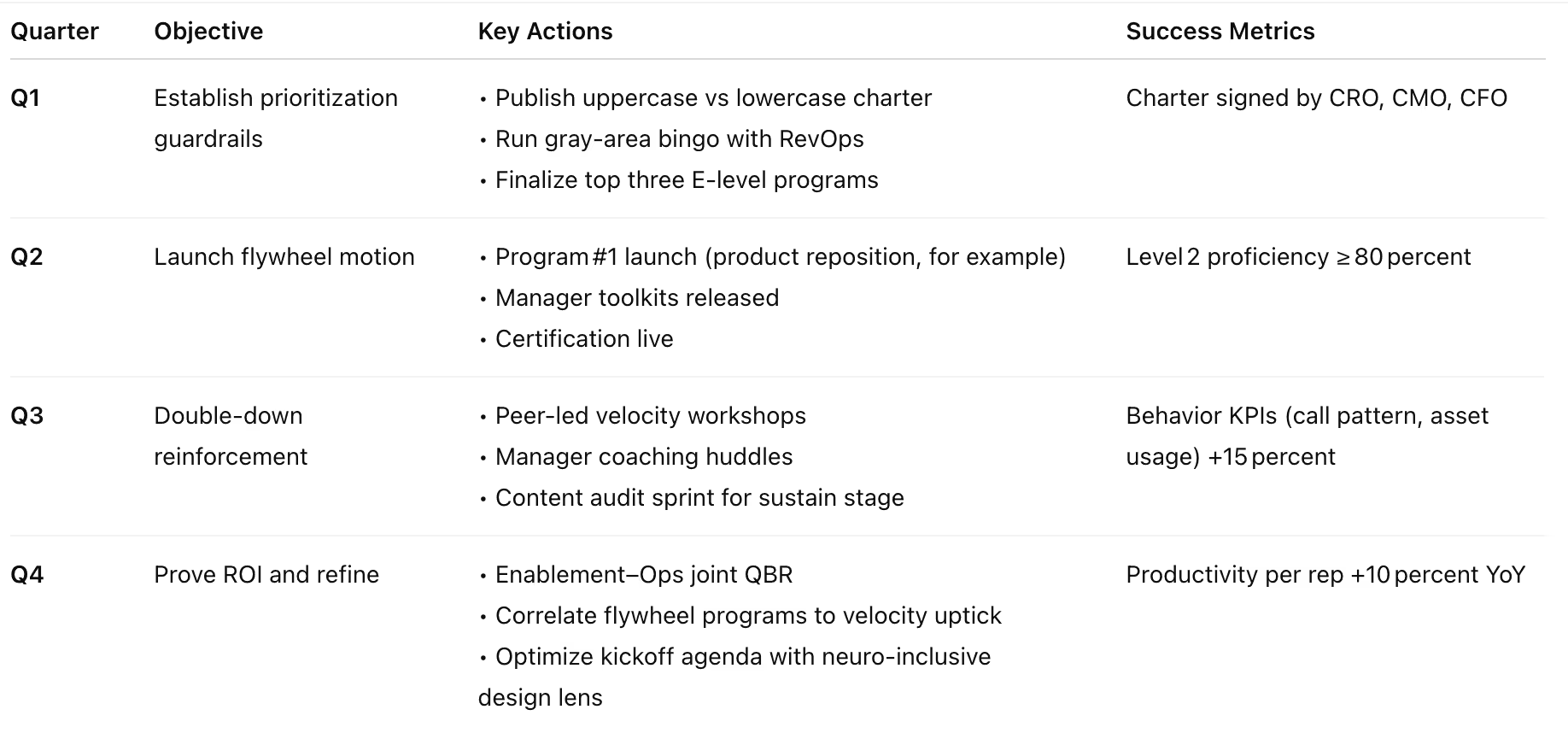
Closing conviction: change is permanent, alignment is optional
Amazon kept shipping in the dot‑com crash. Priceline honed focus amid travel downturns. Their edge? Discipline that scales decisions faster than disruption.
Enablement is that discipline for revenue organizations. It orchestrates priorities, codifies knowledge, and keeps humans—sellers, managers, customers—confident amid chaos. Whitney's frameworks give every leader a concrete path from reactive requests to repeatable performance.
The market will keep shifting. Budgets will keep scrutinizing spend. The companies that win will be those that treat enablement not as training collateral, but as an executive function with measurable lift.
So, gather your RevOps peers, print the flywheel, run the gray‑area grid, and pick your uppercase programs. 2025 will not slow down. But with a rigorous enablement engine, your team will move through the turbulence together—faster, clearer, stronger.
Above all, people buy from brands and sellers they trust to stay credible in the face of change. Alignment is how you earn that trust, deal after deal, quarter after quarter.
Catch the
‍

